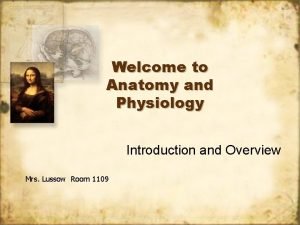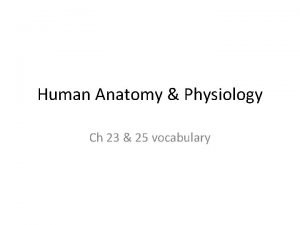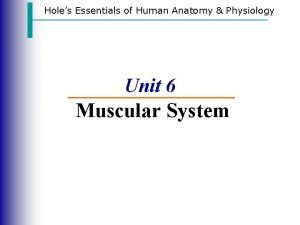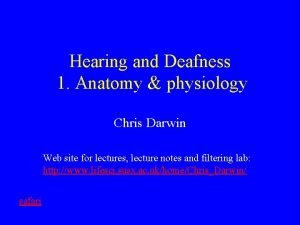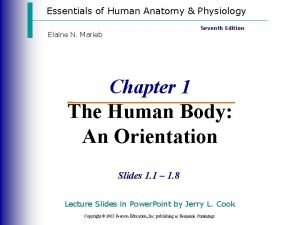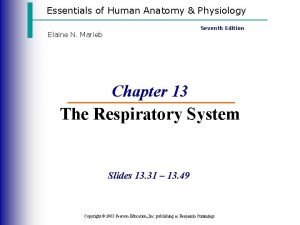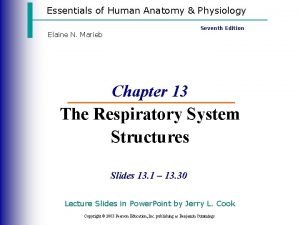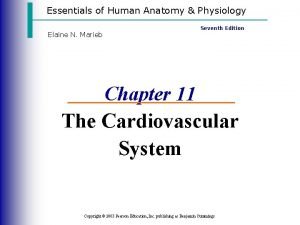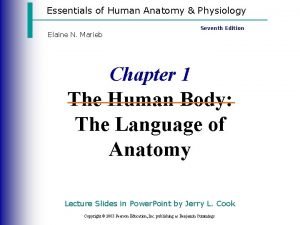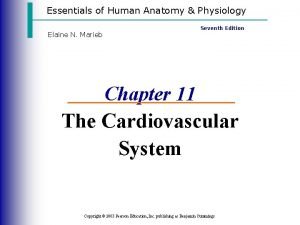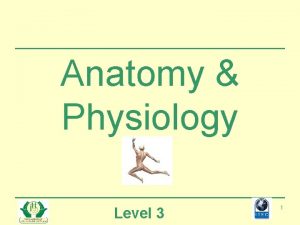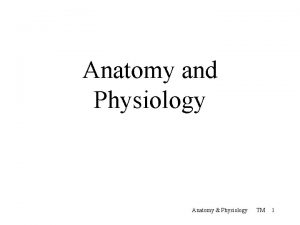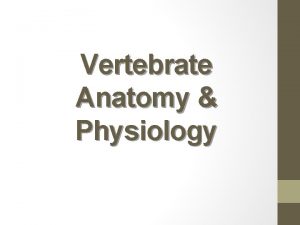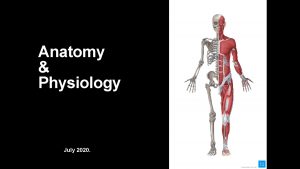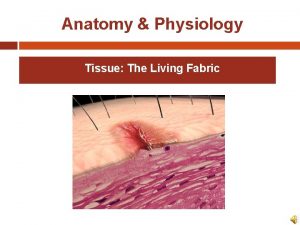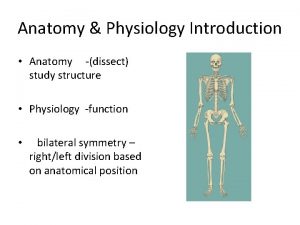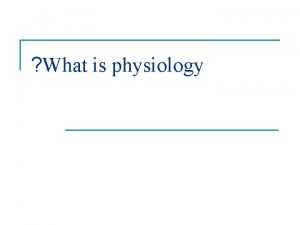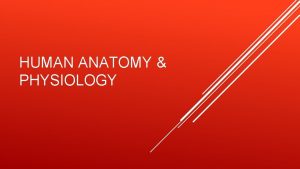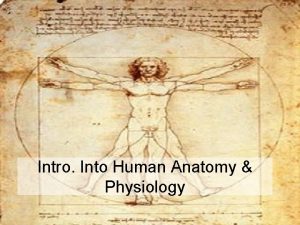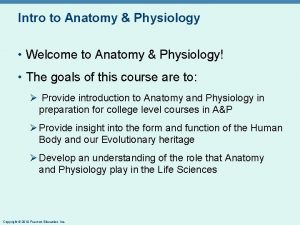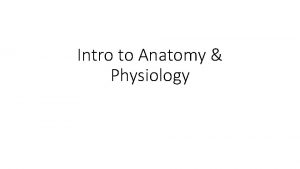Chapter 5 Anatomy Physiology and Pathophysiology National EMS































































- Slides: 63

Chapter 5 Anatomy, Physiology and Pathophysiology

National EMS Education Standard Competencies Anatomy and Physiology Integrates complex knowledge of the anatomy and physiology of the airway, respiratory, and circulatory systems to the practice of EMS Pathophysiology Applies comprehensive knowledge of the pathophysiology of respiration and perfusion to patient assessment and management

Introduction • Anatomy refers to structure and components of human body – Gross anatomy: visible to naked eye – Microscopic anatomy: visible through microscope • Physiology examines body functions • Pathophysiology studies body functions in an abnormal state

Topographic Anatomy • Planes and Lines • Terms of Direction • Terms of Movement • Positions and Postures

The Integumentary System (Skin): Anatomy • Germinal layer of epidermis produces new skin cells • Dermis contains sweat glands, sebaceous glands, hair follicles, blood vessels, specialized nerve endings • Mucous Membranes

The Integumentary System (Skin): Physiology • Functions – Protect the body in the environment – Regulate body temperature – Transmit information from environment to brain

The Skeletal System: Anatomy • Skeleton gives us our recognizable human form, protects vital internal organs. • Bones • Tendons—connect muscles to bones • Ligaments—connect bone to bone • Cartilage—cushions between bones – Lubricated by joint fluid (synovial fluid)

Overview of Bones (2 of 2) Components of a long bone (humerus)

The Skeletal System: Physiology • Bones protect internal organs. • Together with muscles, bones enable movement. • Bone stores minerals. – Particularly calcium • Bone plays role in forming blood cells and platelets.

The Skeleton • Axial • Appendicular • Joints

The Musculoskeletal System: Anatomy • Three types of muscle: – Cardiac • Found only in the heart • Specially adapted – Skeletal – Smooth • Involuntary • In blood vessels, intestines

The Musculoskeletal System: Physiology • Contraction and relaxation make movement possible. • A by-product of movement is heat. • Muscles protect structures under them. – For example, intestines are protected by rectus abdominus muscles.

The Musculoskeletal System: Anatomy (4 of 4)

The Respiratory System: Anatomy • Nose • Mouth • Throat • Larynx • Trachea • Bronchioles • Lungs • Diaphragm • Muscles of chest wall • Accessory muscles of breathing

The Respiratory System: Physiology • Respiration – Exchanges gases • Ventilation – Process of moving air in and out of lungs • Breathing control – – – Medulla Pons Chemoreceptors Carboxic drive Hypoxic drive

Acid-Base Regulation • p. H ranges from 0 (most acidic) to 14 (most basic). • Normal p. H of the human body is 7. 35 to 7. 45. • Buffer systems are defenses against acid-base changes in the body.

Acid-Base Regulation • Hydrogen ions combine with bicarbonate ions to form carbonic acid • Carbonic acid breaks down into carbon dioxide and water • As hydrogen ions are liberated in the body, they combine with bicarbonate ions (action of the buffer system) to resist p. H changes in blood • H+ binds to HCO 3 - to form H 2 CO 3

Acid-Base Regulation • The body attempts to maintain a ratio of HCO 3: H 2 CO 3 of 20: 1 • As carbonic acid is manufactured by the buffer system it breaks down into carbon dioxide and water • H 2 CO 3 produces CO 2 and H 2 O

Acid-Base Regulation • The respiratory system is responsible for maintaining appropriate levels of carbon dioxide in blood • As Carbon dioxide is generated, chemoreceptors send messages to the control centers of the brain • Control centers respond by elevating the respiratory rate

Acid-Base Regulation • The kidneys are responsible for secreting excess hydrogen ions or excess bicarbonate ions in urine in order to maintain appropriate acid-base balance • If blood is acidic, the kidneys secrete hydrogen ions • If blood is alkaline, the kidneys secrete bicarbonate ions • Urine production is a relatively slow process

Acid-Base Abnormalities • Metabolic – Acidosis occurs when the body liberates more hydrogen ions than the kidneys excrete – Alkalosis occurs when the body absorbs more bicarbonate than is eliminated by the kidneys • Respiratory – Acidosis occurs when the body fails to eliminate carbon dioxide – Alkalosis occurs when the body releases too much carbon dioxide

Interpreting Blood Gases • Acidosis = p. H < 7. 35 – Respiratory • p. CO 2 > 45; If compensated, HCO 3 - > 26 mg/dl – Metabolic • HCO 3 - is < 22 mg/dl, p. CO 2 is normal • Alkalosis = p. H > 7. 45 – Metabolic • p. CO 2 < 35 and HCO 3 - is low – Respiratory • HCO 3 - > 26 mg/dl, p. CO 2 is normal

Ventilation (1 of 2) • Tidal volume—air moved in a single breath • Inspiratory reserve volume—deepest breath you can take after normal breath • Expiratory reserve volume—maximum amount of air you can forcibly breathe out after normal breath

Ventilation (2 of 2) • Vital capacity— amount of air moved with maximum inspiration and expiration

Characteristics of Normal Breathing • Normal rate and depth (tidal volume) • Regular rhythm (pattern of inhalation and exhalation) • Good audible breath sounds on both sides of chest • Regular rise and fall movement on both sides of chest • Movement of abdomen

Compromised Breathing Patterns in Adults • Labored breathing • Minute alveolar ventilation < 4200 ml • Muscle retractions (clavicles, ribs) • Pale or cyanotic (blue) skin • Cool, damp (clammy) skin • Tripod position

The Circulatory System: Anatomy • Heart – Location – Chambers, valves, accessory structures – Heartwall and Pericardium • Blood vessels – Types – Circulatory pathways • Blood

Heart Sounds • Created by contraction and relaxation of heart and flow of blood • Heard during auscultation with stethoscope • Normal heart sound: “lub-DUB” • S 1 and S 2 are normal sounds, S 3 and S 4 are often not – Also abnormal: murmurs, bruits, clicks, snaps

The Electrical Conduction System • Electrical stimulus controls mechanical pumping action. • Conduction system components: – – – Sinoatrial (SA) node Atrioventricular (AV) node Bundle of His Right and left bundle branches Purkinje fibers

Regulation of Heart Function • Autonomic nervous system, endocrine hormones, and heart tissue, control: – Rate of contraction (chronotropic state) – Rate of electrical conduction (dromotropic state) – Strength of contraction (inotropic state) • Baroreceptors respond to changes in pressure. • Chemoreceptors sense changes in chemical composition of blood.

The Cardiac Cycle • Process that creates the pumping of the heart – Systole – Diastole • Pulse pressure • Afterload • Stroke volume • Cardiac output = stroke volume × heart rate

Blood Composition • Plasma • Red blood cells – Hemoglobin – Surface Antigens • White blood cells (leukocytes) – Fight infection • Granulocytes (neutrophils, eosinophils, basophils) • Agranulocytes (monocytes, lymphocytes) • Platelets

The Circulatory System: Physiology (1 of 2) • Pulse is created by blood pumping out of left ventricle into major arteries. • Blood pressure is pressure blood exerts against artery walls. – Sphygmomanometer measures high/low points. • Systemic vascular resistance is how dilated or constricted the blood vessels are.

The Circulatory System: Physiology • Average adult has about 5 L of blood – Infants 300 m. L, children 2 to 3 L • Central and peripheral pulses • BP = CO X SVR

The Lymphatic System • Absorb fat from digestive tract, maintain fluid balance, and fight infection • Transports lymph • Lymph nodes interspersed along course of lymph vessels • Lymph vessels absorb excess fluid and return it to the central venous circulation

Cellular Transport Mechanisms • Cell membrane is selectively permeable. • Allows differences in concentrations inside and outside cell

Cellular Transport Mechanisms • Diffusion – Movement of solutes from an area of high concentration to an area of low concentration to produce an even distribution of particles in the space available • Depends on: – Permeability of membrane – Concentration gradient

Cellular Transport Mechanisms • Osmosis – Movement of a solvent from an area of low solute concentration to one of high concentration • Osmotic pressure • Facilitated diffusion • Active transport

Body Fluid Balance • Body fluid is divided into: – Intracellular fluid (ICF) – Extracellular fluid • Intravascular fluid (plasma) • Interstitial fluid • Fluid balance maintains homeostasis • Regulated by – Antidiuretic hormone from pituitary gland – Thirst • Fluid imbalance can be life-threatening

The Nervous System: Anatomy and Physiology • Components • Central nervous system • Peripheral nervous system

The Central Nervous System • Brain • Spinal Cord • Meninges

The Peripheral Nervous System • Divisions – Somatic nervous system – Autonomic nervous system has two parts: • Sympathetic nervous system • Parasympathetic nervous system • Sensory and Motor Nerves • Cranial and Spinal Nerves

The Endocrine System: Anatomy and Physiology (1 of 2) • Made up of glands located throughout body • Glands – Remove, concentrate, or alter materials from blood – Secrete them back into body • Glands secrete proteins called hormones. – Regulate mood, growth and development, metabolism, sexual development, much else

The Endocrine System: Anatomy and Physiology (2 of 2)

The Pituitary Gland the Hypothalamus • Pituitary gland is called “master gland. ” – Its secretions control those of other endocrine glands. – Secretes growth hormone, thyroid-stimulating hormone, adrenocorticotropin hormone, gonadotropic hormones, ADH, oxytocin • Hypothalamus is main link between endocrine system and nervous system.

The Thyroid Gland • Large gland at base of neck • Manufactures and secretes hormones that have role in growth, development, metabolism • Secretes calcitonin – Helps maintain normal calcium levels in blood • Parathyroid glands – Located in thyroid – Secrete parathyroid hormone

The Pancreas • Organ of both the endocrine system and digestive system • Produces insulin and glucagon • Insulin causes uptake and metabolism of sugar, fatty acids, amino acids. • Glucagon stimulates breakdown of glycogen to glucose. – Also stimulates liver and kidneys to produce glucose

The Adrenal Glands • Located on top of each kidney • Secrete: – Sex hormones – Hormones vital in maintaining water and salt balance – Adrenaline (mediates “fight-of -flight” response) – Epinephrine and norepinephrine

The Reproductive Glands and Hormones • Gonads are ovaries in women and testes in men. • Ovaries produce estrogen and progesterone. • Major female hormones • Developing fetus manufactures h. CG – Estrogen – Progesterone – Human chorionic gonadotropin (h. CG) • Testosterone is produced by testes. – And to smaller extent by adrenal glands and ovaries

The Digestive System: Anatomy

The Digestive System: Physiology (1 of 2) • In succession, different secretions (primarily enzymes) are added to food by: – – – Salivary glands Stomach Liver Pancreas Small intestine

The Digestive System: Physiology • Converts food into basic sugars, fatty acids, amino acids • These products cross wall of intestine and travel through portal vein to liver • Liver further processes and stores or transports to heart • Circulatory system then nourishes all cells

The Urinary System: Anatomy and Physiology (1 of 2) • Controls discharge of waste filtered from blood by kidneys • Functions – Controls fluid balance in body – Filters and eliminates wastes – Controls p. H balance

The Urinary System: Anatomy and Physiology (2 of 2) • Components – – Kidneys Ureters Urinary bladder Urethra • This example shows the male urinary system.

The Genital System: Anatomy and Physiology • Controls reproductive processes by which life is created • Male genitalia lie outside pelvic cavity. – Except for prostate gland seminal vesicles • Female genitalia lie inside pelvic cavity. – Except for clitoris and labia

The Male Reproductive System and Organs • Testicles, epididymis, vasa deferentia, penis • Functions – Reproduction – Production of sex hormones – Penis is also part of urinary system

The Female Reproductive System and Organs • Ovaries, fallopian tubes, uterus, cervix, vagina • Functions – Reproduction – Production of sex hormones

Life Support Chain (1 of 2) • Body’s cells require: – Oxygen • Brought by respiratory and circulatory systems – Nutrients • Food broken down by digestive system into glucose • Brought by circulatory system – Removal of wastes • Removed by circulatory system

Life Support Chain (2 of 2) • Aerobic metabolism uses oxygen. – Only possibility for some cells (eg, heart, brain) • Anaerobic metabolism does not use oxygen. – Most cells can operate without oxygen for 1 to 3 minutes. – Lactic acid is a by-product. • Converted back to useful energy source once oxygen becomes available

Pathophysiology (1 of 4) • Study of functional changes that occur when body reacts to disease • Airway patency – Can be impaired by blocked airway – Muscles of breathing can be impaired. – Decreased level of consciousness can impair ventilation.

Pathophysiology (2 of 4) • Respiratory compromise – – – Can be caused by decrease of oxygen in air Fluid in alveoli can prevent gas exchange. Cells will move to anaerobic metabolism. Body can adapt to mild, gradual compromise. Severe or prolonged compromise can cause death.

Pathophysiology (3 of 4) • Shock – Condition in which perfusion is inadequate to organs and tissue – Hypovolemic shock results from lack of blood volume (as from trauma). – Cardiogenic shock results from heart inefficiencies. – Distributive shock results from issues regarding dilation and constriction of blood vessels.

Pathophysiology (4 of 4) • Alteration of cellular metabolism – In strenuous exercise, demand for glucose exceeds supply. – Body burns fats and turns them into glucose. – This process is inefficient, but body can sustain for a while. – If there are breathing or perfusion problems, however, process can cause damage or death.
 The central sulcus divides which two lobes? (figure 14-13)
The central sulcus divides which two lobes? (figure 14-13) Chapter 1 introduction to human anatomy and physiology
Chapter 1 introduction to human anatomy and physiology Anatomy and physiology chapter 8 special senses
Anatomy and physiology chapter 8 special senses Chapter 13 anatomy and physiology of pregnancy
Chapter 13 anatomy and physiology of pregnancy Chapter 2 basic chemistry anatomy and physiology
Chapter 2 basic chemistry anatomy and physiology Chapter 7:9 lymphatic system
Chapter 7:9 lymphatic system Anatomy and physiology coloring workbook figure 14-1
Anatomy and physiology coloring workbook figure 14-1 Chapter 10 blood anatomy and physiology
Chapter 10 blood anatomy and physiology Anatomy and physiology chapter 15
Anatomy and physiology chapter 15 Anatomy and physiology chapter 1
Anatomy and physiology chapter 1 Holes anatomy and physiology chapter 1
Holes anatomy and physiology chapter 1 Gi tract histology
Gi tract histology Chapter 1 introduction to anatomy and physiology
Chapter 1 introduction to anatomy and physiology Chapter 2 human reproductive anatomy and physiology
Chapter 2 human reproductive anatomy and physiology Anterior surface of scapula
Anterior surface of scapula Chapter 6 general anatomy and physiology
Chapter 6 general anatomy and physiology Anterior posterior ventral dorsal
Anterior posterior ventral dorsal Inspiration anatomy and physiology
Inspiration anatomy and physiology Tattoo anatomy and physiology
Tattoo anatomy and physiology Science olympiad anatomy and physiology
Science olympiad anatomy and physiology Crown plants examples
Crown plants examples Anatomy and physiology bones
Anatomy and physiology bones Pud triple therapy
Pud triple therapy Liver anatomy and physiology
Liver anatomy and physiology Difference between anatomy and physiology
Difference between anatomy and physiology Epigastric region
Epigastric region Red blood cells anatomy and physiology
Red blood cells anatomy and physiology 3 layers of muscle
3 layers of muscle Http://anatomy and physiology
Http://anatomy and physiology Anatomy and physiology of appendix
Anatomy and physiology of appendix Aohs foundations of anatomy and physiology 1
Aohs foundations of anatomy and physiology 1 Aohs foundations of anatomy and physiology 1
Aohs foundations of anatomy and physiology 1 Anatomy and physiology of swine
Anatomy and physiology of swine Unit 26 agriscience
Unit 26 agriscience Science olympiad forensics cheat sheet
Science olympiad forensics cheat sheet Liver anatomy and physiology ppt
Liver anatomy and physiology ppt Anatomy and physiology of pancreas
Anatomy and physiology of pancreas Aohs foundations of anatomy and physiology 1
Aohs foundations of anatomy and physiology 1 Aohs foundations of anatomy and physiology 1
Aohs foundations of anatomy and physiology 1 What produces bile
What produces bile Cornell notes for anatomy and physiology
Cornell notes for anatomy and physiology Anatomy and physiology ninth edition
Anatomy and physiology ninth edition Holes essential of human anatomy and physiology
Holes essential of human anatomy and physiology Anatomy and physiology unit 7 cardiovascular system
Anatomy and physiology unit 7 cardiovascular system Anatomy and physiology
Anatomy and physiology The speed at which the body consumes energy
The speed at which the body consumes energy Aohs foundations of anatomy and physiology 1
Aohs foundations of anatomy and physiology 1 Animal physiology exam 1
Animal physiology exam 1 Welcome to anatomy and physiology
Welcome to anatomy and physiology Physiology of the foot and ankle
Physiology of the foot and ankle Anatomy and physiology of psoriasis
Anatomy and physiology of psoriasis Pancreas anatomy and physiology
Pancreas anatomy and physiology Anatomy and physiology vocabulary
Anatomy and physiology vocabulary Anatomy and physiology
Anatomy and physiology Biceps muscle names
Biceps muscle names Anatomy and physiology
Anatomy and physiology Organ orientation
Organ orientation Anatomy and physiology
Anatomy and physiology Anatomy and physiology
Anatomy and physiology Anatomy and physiology
Anatomy and physiology Anatomy and physiology
Anatomy and physiology Anatomy and physiology
Anatomy and physiology Anatomy and physiology
Anatomy and physiology Anatomy and physiology
Anatomy and physiology
















































